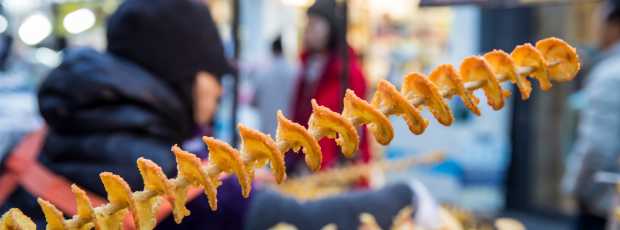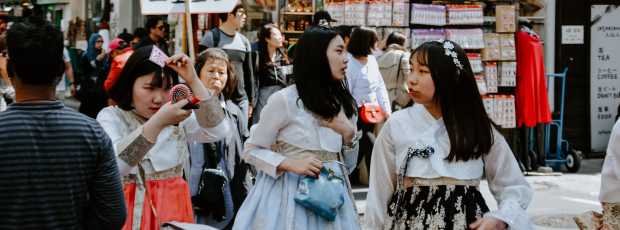My four hours with GJ was absolutely excellent. It was a Hidden Gems Tour and she took me off the beaten path exactly as promised. I felt like I made a new friend and learned so much about new areas of Seoul. It was exactly what I asked for.Sasha, Seoul, 2025
Taste Seoul’s real flavors on a private food tour
Eat where locals actually go
Table Of Contents
- What Are the Signature Korean Foods You Need to Try?
- Where Does Seoul's Global Food Scene Show Up?
- What Street Food Matters in Seoul?
- What About Desserts That Aren't From Cafés?
- What Should You Drink Besides Soju?
- Which Neighborhoods and Markets Should You Prioritize for Food?
- What Food Traditions Shape How Locals Eat?
- What Seasonal Foods Change the Eating Calendar?
- What Food Experiences Should You Skip or Adjust?
- What Do You Need to Know Before Eating Here?
- Frequently Asked Questions
- Final Thoughts: How to Eat Like You Live Here
I'm Taeyang, and this won't be a simple, generic food guide.
I'll tell you about the bindaetteok that's been fried in the same pan at Gwangjang Market for thirty years, the pojangmacha where I bring guests for soju and ramyeon at 1 AM, and why you should never trust a BBQ place that doesn't smell like charcoal smoke from two blocks away.
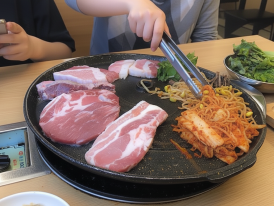
Sizzling samgyeopsal on a hot grill
I host street food strolls through Gwangjang and Dongdaemun. I've mapped every worthwhile Seoul experience with samgyeopsal alley in Mapo by the quality of their smoke. I know which jeon house makes the best pancakes on rainy nights and which makgeolli pairs with them. This is Seoul's food scene the way locals actually eat it: messy, loud, seasonal, and completely unapologetic. Sure, not all the places I recommend are hidden gems, but they're still absolutely worth checking out.
Let me walk you through it.

Clay pot of kimchi jjigae bubbling with pork belly and tofu
What Are the Signature Korean Foods You Need to Try?
These are the dishes that define Seoul's table. Not trendy, not photogenic by default, just the Korean food that locals order without thinking twice.
Kimchi Jjigae (Kimchi Stew)
This is the dish that tells you if a place knows what it's doing. Good kimchi stew should be sour, funky, and just spicy enough to make you reach for more rice. The kimchi needs time to ferment properly. Fresh kimchi in jjigae is a rookie mistake.
I order this when I need something that feels like home cooking without the effort. Most neighborhood diners serve it in a stone pot with pork belly, tofu, and enough broth to soak three bowls of Korean rice. You'll find side dishes covering your table before the stew even arrives. That's normal. Eat them.
Near Gwanghwamun, I squeeze into Gwanghwamun Jip for sour, porky kimchi jjigae served boiling in stone pots. It's a relatively tiny place, but the food is beyond amazing, in my humble opinion.
The best versions use old kimchi, the kind that's been sitting in someone's fridge for months getting properly sour. Some places add gochugaru for extra heat. Others throw in a handful of glass noodles. It costs less than most coffee drinks and fills you up for hours.
Want to Experience Seoul Firsthand?
Step into the neighborhood, scene, or story with someone who knows it inside out.

Vendor flipping golden mung bean pancakes at Gwangjang Market
Samgyeopsal (Pork Belly BBQ)
If you visit Seoul and skip Korean BBQ, I'm not sure we can be friends. Samgyeopsal is thick-cut pork belly grilled over charcoal at your table. You wrap it in lettuce with garlic, ssamjang (a spicy sauce made with fermented soybean paste), and whatever banchan strikes your mood.
Mapo is samgyeopsal headquarters. I host groups there because the smoke, the sizzle, and the communal grilling vibe can't be faked. Look for places with actual charcoal, not gas burners. The charcoal matters. Gas gives you cooked meat. Charcoal gives you Korean barbecue.
For charcoal pork belly in Mapo, I default to Mapo Jeong Daepo. This is one of the few places I will always recommend. It's not one of the most famous places, but absolutely worth it. You'll queue after 6:30 PM and leave perfumed with smoke in the best way.
Etiquette: pour soju for the person next to you, never yourself. Share the scissors to cut the meat. If you're in a traditional room, take your shoes off. And for the love of everything grilled, don't stick your chopsticks upright in the rice. That's funeral ritual territory. Charcoal changes Korean barbecue from cooked meat to smoke-kissed ritual.
Expect to queue after 6:30 PM. The wait's worth it. Go earlier if you hate crowds, but you'll miss the evening energy when everyone's unwinding after work with meat and beer.

Charcoal galbi grilling on a dome grill
Bulgogi and Charcoal Galbi
Bulgogi is marinated beef, sweet and savory, often cooked on a dome-shaped grill. Galbi is beef short ribs, usually marinated in soy sauce, sugar, garlic, and sesame oil. Both are Korean foods that tourists know by name, but locals eat them at specific places for specific reasons.
When I want beef done deliberate, I book it to Woo Lae Oak for charcoal bulgogi and galbi, then cool off with a bowl of their icy naengmyeon. The marinade balances sweet and umami without turning into candy. You still get the wrap-it-in-lettuce routine, but the quality of the beef makes it feel more deliberate.
Bulgogi works better as a shared dish. It's less theatrical than galbi, but the marinade soaks into the rice if you pour the juices over it. Most Korean restaurants serve it with lettuce wraps and a pile of side dishes. Some throw in mushrooms or glass noodles.
Bibimbap (Mixed Rice Bowl)
Bibimbap means "mixed rice." You get a bowl of warm rice topped with vegetables, a fried egg, gochujang (red chili paste), and usually beef. You stir it all together until the egg yolk coats everything and the gochujang turns it spicy.
Stone pot bibimbap (dolsot bibimbap) is the superior version. The rice at the bottom crisps up against the hot stone, giving you texture contrast. I order this when I want something that feels complete without needing five other dishes on the table.
Jeonju-style bibimbap is the fancy regional take, with more ingredients and higher quality beef tartare. But honestly, most neighborhood spots serve a solid version that'll cost you the price of a sandwich back home. Add sesame oil if the restaurant offers it. It ties everything together.
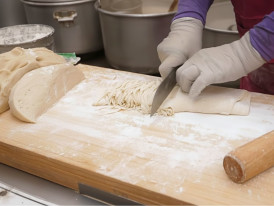
Kalguksu noodles being hand-cut into strips
Kalguksu (Knife-Cut Noodles)
Hand-cut wheat knife cut noodles in anchovy broth with zucchini and clams. Markets and street food stalls ladle it fast; older shops near subway stations still roll and slice by hand. It's cheap, restorative, and proof that not all great Korean foods are grilled.
For broth therapy and flying noodles, duck into Namdaemun Kalguksu Alley, hand-cut, ladled fast, and close to the station.
Dakgalbi (Spicy Stir-Fried Chicken)
Dakgalbi is spicy chicken stir-fried with sweet potato, cabbage, and tteok (rice cakes) on a big communal pan. It's messy, it's interactive, and it's cheaper than most Korean BBQ options. Chuncheon, a city outside Seoul, claims dakgalbi as its specialty, but you'll find solid versions all over the city.
The gochujang-based marinade hits harder than samgyeopsal's smoky char. You cook it together at your table, usually with a side of fried rice at the end to soak up the leftover sauce. I bring guests here when they want group eating that doesn't require perfect grilling technique.
It's not refined. It's sticky, spicy, and fills up a table. That's the point.
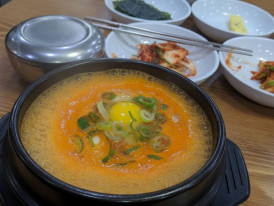
Bubbling sundubu jjigae with a raw egg
Sundubu (Soft Tofu Stew)
Silky tofu in a bubbling red soft tofu stew that looks fierce but eats gentle. Cracked raw egg on top, a spoon of sesame oil, and a mountain of side dishes make this the comfort order locals reach for in winter. It's classic Korean food that welcomes spice-shy friends.
Naengmyeon (Korean Cold Noodles)
Naengmyeon is buckwheat noodles served in an icy broth with sliced pear, cucumber, and a hard-boiled egg. Mul naengmyeon is the cold soup version. Bibim naengmyeon skips the broth and goes heavy on spicy gochujang sauce.
This is summer food in Seoul. When it's humid and brutal outside, you eat naengmyeon. Woo Lae Oak in Euljiro (Jung-gu), a short subway ride from Seoul Station, has been serving it since before I was born. The broth is extra icy, the noodles have chew, and the mustard on the side adds a sharp kick if you want it.
The noodles originally came from North Korea, which gives the dish some historical weight that I won't pretend to unpack fully here. What matters: the noodles are long, you're supposed to cut them with scissors before eating, and the cold broth is weirdly addictive once you adjust to the idea of cold soup in summer.
If you need a benchmark for buckwheat chew and clean broth, Pyeongyang Myeonok is the yardstick locals measure by.
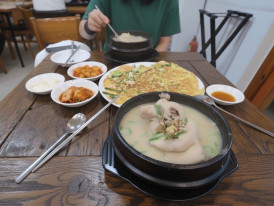
Clay bowl of samgyetang with ginseng, dates, and rice
Samgyetang (Ginseng Chicken Soup)
Samgyetang is a whole young chicken stuffed with sticky rice, ginseng, jujubes, and garlic, simmered in broth until it falls apart. It's stamina food, eaten on the hottest days of summer to fight heat with heat. Yes, that sounds backwards. No, I don't make the rules.
The concept is called "fighting fire with fire" (이열치열). You eat hot soup in July humidity because it's supposed to boost energy and balance your body. Whether it works or not, samgyetang is comfort food when you're drained from the heat.
You'll find it served in clay bowls. The chicken is tender enough to pull apart with chopsticks. The rice inside soaks up all the ginseng and garlic flavor. Some places add extra sesame seeds or chopped scallions. It's rich without being heavy, which is a weird trick for a dish built around an entire chicken.
Where Does Seoul's Global Food Scene Show Up?
Seoul doesn't live on Korean food alone. Immigrant influences and expat communities carved out their own corners, and the delivery culture runs deeper than most cities manage.

Food in a metal delivery box outside of an apartment
Chinese-Korean Delivery Culture
Jjajangmyeon is thick wheat noodles in black bean sauce, and it's one of the favorite Korean dishes that actually started as Chinese food adapted for local taste. You order it when you're too lazy to cook, usually with tangsuyuk (sweet and sour pork) on the side.
Delivery drivers in Seoul are aggressive and efficient. They'll find your apartment faster than you can. Jjajangmyeon arrives in metal containers, and yes, you're supposed to return them later. Most people do. The system works.
On nights I don't want to cook, Hong Kong Banjeom 0410 finds my door faster than my friends do. If I'm near Myeong-dong, I slide into Gaehwa for jjajangmyeon and tangsuyuk without opening an app.
This is Chinese-Korean fusion at its most practical. The black bean sauce is thicker and sweeter than anything you'd get in China. The noodles are hand-pulled if you're lucky, machine-cut if you're not. It costs about the same as a convenience store lunch box but feels like more of an event.
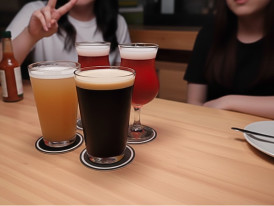
Craft beer in Itaewon. More expensive than soju, worth the variety
Itaewon's International Kitchens
Itaewon has always been Seoul's international food belt, shaped by the US military base nearby and decades of expat communities setting up restaurants. You'll find Turkish kebabs, Indian curries, Mexican tacos, Thai noodles, and Italian pasta within a three-block radius.
It's not "authentic" in the way food snobs measure authenticity. It's adapted for Seoul palates and prices. But when you've eaten Korean street food for six days straight and need something different, Itaewon delivers.
Craft beer bars cluster here too. The beer scene in Seoul exploded over the last decade, and Itaewon was ground zero. You'll pay more than you would at a pojangmacha tent, but the beer variety makes up for it.
Café Desserts in Seongsu and Gangnam
Seoul's café culture rivals its restaurant scene in terms of sheer density. Seongsu is the current trendy district for specialty coffee and dessert labs that treat pastries like gallery installations. Gangnam still has its high-end café chains with fruit tarts and Earl Grey lattes.
I'm not particularly interested in café hopping, but I'll admit the bingsu (shaved ice dessert) game here is strong. Seoul does shaved ice better than most places, layering it with red beans, fruit, condensed milk, and sometimes rice cakes or mochi. It's a summer ritual that Southeast Asia does differently but Seoul perfected in its own way.
If you need a break between street food stalls and BBQ sessions, find a café near a palace or along the Han River. The coffee's overpriced but decent, and you can sit for hours without anyone rushing you out.
What Street Food Matters in Seoul?
Street food in Seoul isn't just a tourist activity; there are many things to do in Seoul with a focus on food that will leave you more than satisfied.
For me, and many others, it's all about how people snack between meals, grab late-night fuel after drinks, and survive winter cold. The vendors know their product inside out because they've been making the same thing for years. This is Korean street food the way locals actually use it.

Bright red tteokbokki bubbling in a wide pan at a street stall
Tteokbokki (Spicy Rice Cakes)
Tteokbokki is chewy rice cakes in gochujang-based sauce, usually served with fish cakes (eomuk) and boiled eggs. It's spicy, slightly sweet, and coats your tongue with that addictive Korean chili flavor. Every food stall and corner restaurant serves some version of it.
The rice cakes should have chew without being rubbery. The sauce should stick without being gloppy. Some vendors throw in ramen noodles or cheese, which sounds wrong but works if you're drunk at midnight.
I eat this at Gwangjang Market when I'm cold and want something that warms me from the inside. It costs pocket change and fills you up fast. Don't expect elegance. Expect spicy, chewy comfort.
Eomuk (Fish Cake Skewers and Broth)
Eomuk are fish cakes on skewers, served with hot broth on the side. You drink the broth to cut the cold. The fish cakes are mild, slightly sweet, and more about texture than strong flavor.
Street vendors sell these near subway stations and markets. The broth is free. You pay for the skewers by counting your sticks when you're done. It's an honor system that somehow still works.
On cold nights, the broth alone is worth stopping for. It's anchovy-based, lightly salted, and exactly what you need when you're walking between neighborhoods and your hands are freezing.
Gimbap and Convenience Store Culture
Gimbap is Korean sushi rolls: rice and fillings wrapped in seaweed. Fillings range from vegetables and ham to kimchi and tuna. It's portable, cheap, and sold everywhere from street vendors to convenience stores.
Mayak gimbap at Gwangjang Market is the famous version: tiny rolls, lightly seasoned, served with mustard-spiked soy sauce. "Mayak" means "drug" because people claim it's addictive. It's not that deep. They're just well-made mini rolls that you eat ten of before realizing you're full.
Convenience stores like GS25 and CU sell pre-packaged gimbap, triangle kimbap (onigiri-style), and instant ramyeon that you cook in the store's hot water station. This is late-night food culture. I've had more 2 AM convenience store meals than I care to admit, and I'm not ashamed. Banana milk from the fridge after a night of drinking is a Seoul tradition.
Convenience-Store Survival
GS25 and CU are a late-night pantry: triangle gimbap, cup ramyeon, banana milk, and heat lamps that revive you between neighborhoods. Not glamorous, but if you truly want to eat in Seoul, this is the real baseline.
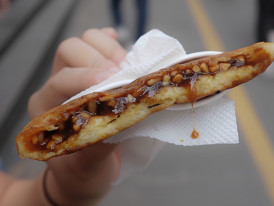
Steaming hotteok with brown sugar syrup oozing
Hotteok (Sweet Pancakes)
Hotteok is fried dough filled with brown sugar, cinnamon, and chopped nuts. It's winter street food, sold from carts near markets and subway exits. The vendor presses the dough flat on the griddle, and the sugar melts into syrup inside.
You bite into it carefully because the filling is lava-hot. The outside is crispy, the inside is sweet and gooey, and it costs about a dollar. I eat this walking between Namdaemun Market and Seoul Station when I need a sugar hit and my fingers are cold.
Some vendors add seeds or sweet potato filling. The classic brown sugar version is still the best. Don't overthink it.

Bungeoppang with red bean filling
Bungeoppang (Fish-Shaped Pastry)
Bungeoppang is a fish-shaped pastry filled with sweet red bean paste. It's cooked in a metal mold that gives it a crispy outside. The red beans inside are mashed into a paste that's sweet but not cloying.
This is another winter traditional snack. Vendors sell it near markets and busy intersections. You eat it hot, straight from the mold, while walking. The fish shape is just for tradition and aesthetics. Nobody cares about the shape once they bite into the red bean filling.
Some stalls offer variations with custard or Nutella, but the original sweet tasting red bean version is the standard. It's comfort food that costs pocket change.
Sundae (Blood Sausage)
Sundae is Korean blood sausage: pig intestine stuffed with glass noodles, pork blood, and rice. It's served sliced with a side of salt and sometimes liver or lung. This is not for everyone, but if you eat offal, sundae is worth trying at a market stall.
The texture is soft and slightly gelatinous. The flavor is mild and earthy. You dip it in salt or a spicy sauce depending on the vendor's setup. It's one of those Korean street food items that locals eat without thinking twice but makes tourists nervous.
I won't push it on you, but if you see it at Gwangjang and you're curious, go for it. It's less intense than you'd expect.
Gyeran-ppang (Egg Bread)
Gyeran-ppang translates to "egg bread," and it's exactly that: a slightly sweet bread with a whole egg baked into the top. It's sold from street carts and convenience stores, usually near schools and subway stations.
The bread is fluffy and warm. The egg adds richness. It's not fancy, but it's a reliable snack when you're cold and want something that feels like breakfast even though it's 4 PM. I eat this more than I should when I'm rushing between neighborhoods.
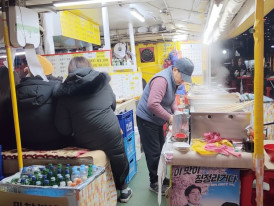
Plastic food tent stall at night with soju bottles and patrons waiting
Late-Night Tent Culture (Pojangmacha)
Pojangmacha are plastic tent stalls set up on sidewalks at night. You sit on wobbly stools, order instant ramyeon or tteokbokki, and drink soju from metal cups. The lighting is harsh, the seating is unstable, and the whole thing feels temporary because it is. The tents pack up before dawn.
This is where I bring guests after midnight when they want to experience Seoul's late-night food culture without pretense. The food isn't gourmet. It's instant noodles cooked on a portable burner with whatever the vendor has on hand. But the vibe is unbeatable.
You'll see office workers unwinding, couples sharing ramyeon, and solo diners nursing soju while scrolling their phones. It's communal and isolating at the same time. Very Seoul.

Korean fried chicken pieces with beer
Chimaek (Chicken and Beer)
Chimaek is deep fried chicken paired with beer. It's not street food in the literal sense, but it's casual, it's everywhere, and it's part of Seoul's after-work food culture. Korean fried chicken is double-fried for extra crispiness, and it comes in flavors ranging from plain (후라이드) to spicy (매운맛) to soy garlic glazed.
Post-midnight in Hongdae, Kyochon Chicken still ruins my willpower with honey half-half. If the table needs heat, BHC Chicken's Red King with cheap lager is the move.
Hongdae and Yeonnam-dong have the highest density of chicken joints. You'll see groups crowded around tables covered in aluminum beer cans and chicken bones. The chicken is deep fried until the skin shatters when you bite it. The beer is usually cheap lager that pairs perfectly with the grease.
I've eaten more chimaek than is probably healthy, and I regret nothing. It's best eaten with friends, late at night, when someone suggests "one more round" and everyone agrees even though they're already full.
What About Desserts That Aren't From Cafés?
Seoul's sweet game runs beyond Instagram-ready café culture. Markets, street carts, and seasonal vendors handle the rest.
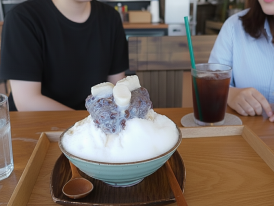
towering bingsu with red beans, rice cakes, and condensed milk drizzle
Bingsu (Shaved Ice)
Bingsu is Korea's answer to shaved ice dessert, but it's more than just ice and syrup. The ice is shaved so fine it's almost snow-like. Traditional patbingsu comes with sweet red beans, rice cakes, and condensed milk. Modern Korean versions add fruit, ice cream, Nutella, or matcha powder.
I eat bingsu in summer when the humidity makes you want to sit in air conditioning for three hours. It's a shared dessert. You order one massive bowl and dig in with multiple spoons. Some places make the ice from frozen milk instead of water, which gives it a creamier texture.
Seongsu and Gangnam cafés go overboard with presentation, turning bingsu into Instagram bait. But the classic patbingsu served at older spots near Insadong or Jongno is still the most satisfying version. Less photogenic, more flavor.
Market Sikhye (Sweet Rice Drink)
Sikhye is a sweet rice drink served cold, usually with a few grains of cooked rice floating at the bottom. It's made from fermented malt and has a subtle ginger flavor. You'll find it at traditional markets and some restaurants as a palate cleanser or dessert drink.
It's refreshing without being overly sweet. I drink it after heavy meals at Namdaemun Market when I need something light to cut through the grease. It's not a dessert in the cake-and-frosting sense, but it fills that after-meal sweet spot.
Some convenience stores sell it in cans, but the fresh version from market vendors is better. The texture and temperature make a difference.
Soju etiquette rules are real but flexible depending on who you're drinking with.
What Should You Drink Besides Soju?
Soju dominates, but Seoul's drinking culture includes rice wine rituals, craft beer pockets, and sweet drinks that cut through the grease.
Soju Etiquette and Reality
Soju is Korea's most consumed alcohol: distilled, clear, about 16-20% ABV depending on the brand. It tastes like slightly sweet vodka. You drink it in shot glasses, and you pour for others, not yourself.
The etiquette rules are real but flexible depending on who you're drinking with. Use two hands when pouring for someone older. Turn your head slightly when drinking if you're with elders. Don't refuse the first pour. After that, pace yourself however you want.
I drink soju at BBQ dinners and pojangmacha tents. It pairs with grilled meat and spicy food because it cuts through fat and heat without adding its own strong flavor. The cheap brands (참이슬, 처음처럼) are fine. The expensive stuff isn't that different.
Some restaurants will include soju with late-night food orders, especially on rainy nights when everyone's craving jeon and drinks, though alcohol delivery rules vary. Tipping isn't standard, but the system somehow works.
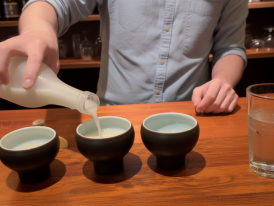
A bartender pouring makgeolli for a tasting
Soju Etiquette and Reality
Soju is Korea's most consumed alcohol: distilled, clear, about 16-20% ABV depending on the brand. It tastes like slightly sweet vodka. You drink it in shot glasses, and you pour for others, not yourself.
The etiquette rules are real but flexible depending on who you're drinking with. Use two hands when pouring for someone older. Turn your head slightly when drinking if you're with elders. Don't refuse the first pour. After that, pace yourself however you want.
I drink soju at BBQ dinners and pojangmacha tents. It pairs with grilled meat and spicy food because it cuts through fat and heat without adding its own strong flavor. The cheap brands (참이슬, 처음처럼) are fine. The expensive stuff isn't that different.
Some restaurants will include soju with late-night food orders, especially on rainy nights when everyone's craving jeon and drinks, though alcohol delivery rules vary. Tipping isn't standard, but the system somehow works.
Makgeolli and Rainy-Day Jeon
Makgeolli is milky rice wine, slightly fizzy, with a tangy sweetness. It's lower in alcohol than soju (around 6-9% ABV) and pairs perfectly with jeon (traditional Korean pancakes) on rainy days.
This is a Seoul ritual: when it rains, you eat jeon and drink makgeolli. I host guests at makgeolli houses in Jongno when the forecast calls for rain. The combination of savory, crispy pancakes and slightly sweet, fizzy rice wine is one of those food pairings that just works.
When the forecast turns, I steer groups to Gongdeok Jeon Alley for scallion pancakes and kettles of rice wine.
Makgeolli is traditionally served in brass kettles or wooden bowls. You shake the bottle before pouring because the sediment settles at the bottom. The first sip tastes weird if you're expecting beer or soju. By the third sip, you get it. Personally, I recommend this spot for Seoul day trips that will be both memorable and affordable.
For a gentler on-ramp to rice wine, Neurin Maeul Makgeolli pours clean and pairs it with simple anju.
Craft Beer Belts
Seoul's craft beer scene is concentrated in Itaewon, Gyeongridan, and Hongdae. You'll find IPAs, stouts, sours, and seasonal brews from local breweries like Magpie and The Hand and Malt. The prices are higher than soju or makgeolli, but the beer quality is solid.
I'm not a beer snob, but I'll admit the variety here beats what you'd find at standard Korean bars. The craft beer bars tend to attract younger crowds and expats. The vibe is more relaxed than pojangmacha tents but less formal than traditional drinking houses.
If you want beer without the craft scene price tag, convenience stores sell local lagers like Cass and Hite for cheap. You can drink them on the street, at Han River parks, or in your hotel room. Nobody judges.
Too Many Lists, Not Enough Clarity?
We make exploring simple by connecting you with someone who knows the city and helps you spend your time on what matters to you.
See how it worksWhich Neighborhoods and Markets Should You Prioritize for Food?
Seoul spreads its best eating across districts and markets, each with its own rhythm. Skip the center. Follow the smoke and the market steam.
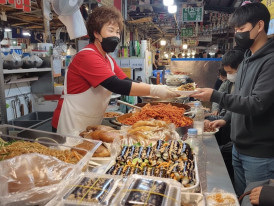
Vendor at Gwangjang Market selling Mayak gimbap and other foods
Gwangjang Market
Gwangjang Market is Seoul's oldest traditional market, and it's where I bring guests who want to eat like locals without the influencer gloss. The bindaetteok (mung bean pancakes) here are fried in giant pans, crispy on the outside, soft inside, served with a side of makgeolli if you want it.
Mayak gimbap is the other famous item: tiny rice rolls that cost next to nothing and somehow taste better than fancy versions elsewhere. The raw beef (yukhoe) stalls serve beef tartare with a raw egg on top, sesame oil, and pear slices. It's not for everyone, but if you eat raw beef, this is the place.
When I host a small walking tour, we eat standing at stalls, then sit for BBQ when the smoke starts to roll. The market is step-free but gets narrow at peak times (11 AM to 2 PM, then again at dinner). Go before 11 AM or after 2 PM if you hate crowds. Vendors prefer cash. Expect to stand or sit on small stools at communal tables. The lighting is harsh and the setup is no-frills. That's the point.
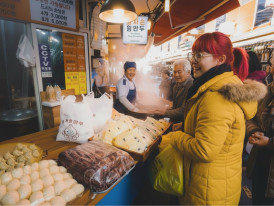
Crowded Namdaemun Market alley with steam rising from food stalls
Namdaemun Market
Namdaemun is Seoul's largest traditional market, sprawling across multiple blocks near Seoul Station. It's less about sit-down eating and more about walking with your favorite street foods in hand. Hotteok vendors line the alleys. For molten centers that will absolutely burn your tongue, head straight to Namdaemun Hotteok Alley. You'll find kalguksu (knife-cut noodles) stalls serving hot broth with hand-cut wheat noodles.
The food stalls here cater to locals doing grocery shopping, which means prices stay reasonable. The energy is more frantic than Gwangjang. It's louder, more crowded, and harder to navigate if you don't speak Korean. Google Translate helps, but pointing also works.
Subway access is easy: exit Seoul Station and walk five minutes. The market opens early and stays busy until evening. If you're arriving at Incheon Airport and coming through Seoul Station, this is a decent first meal stop.
Curious What You Won’t Find Online in Seoul's Markets?
Discover the side only locals talk about.
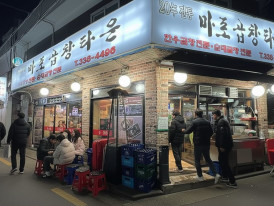
Mapo Gopchang Town restaurant in Mapo BBQ alley
Mapo BBQ Alleys
Mapo is samgyeopsal headquarters. The neighborhood has entire streets dedicated to pork belly restaurants, most using charcoal grills. The smoke, the noise, the crowds lining outside; it's Seoul's BBQ culture at full volume.
I bring groups here when they want the communal grilling experience without overthinking which restaurant to pick. Most places on the main strips are solid. Look for charcoal smoke. Avoid anywhere using gas burners. The charcoal matters.
Expect queues after 6:30 PM. The wait can hit 30-40 minutes at popular spots, but you'll see people drinking soju on the sidewalk while they wait. That's normal. Go earlier if you want faster seating, but you'll miss the evening energy.
Hongdae and Yeonnam-dong: Chicken and Youth Food
Hongdae is Seoul's university district, which means cheap eats, late-night chicken joints, and street food vendors catering to students. The traditional Korean fried chicken here is everywhere, coated in sweet-spicy sauces or fried plain with pickled radish on the side.
Yeonnam-dong, just west of Hongdae, has mellowed into a café and small-restaurant district with less chaos than the main Hongdae strip. You'll find hot dogs (Korean corn dogs with mozzarella and sugar coating), tteokbokki stalls, and bars that stay open until 4 AM.
This is where Seoul's younger food trends show up first: cheese-filled everything, oversized desserts, fusion experiments that sometimes work. I'm not the target demographic, but the energy is undeniable. Go here if you want to see what the under-30 crowd is eating and drinking.
Want to Experience Hongdae Firsthand?
Step into the neighborhood, scene, or story with someone who knows it inside out.
Seongsu Cafés and Dessert Labs
Seongsu used to be an industrial neighborhood. Now it's Seoul's trendy coffee and dessert district, full of converted warehouses hosting specialty coffee roasters and pastry shops that treat croissants like sculpture.
I'm not particularly into café culture, but the bingsu and coffee here are legitimately good. It's also quieter than Hongdae and less touristy than Insadong. If you need a break from street food stalls and want to sit somewhere clean with AC, Seongsu works.
The vibe skews young and design-conscious. Expect minimalist interiors, expensive lattes, and desserts arranged like art installations. It's the opposite of pojangmacha energy, which is fine. Seoul has room for both.
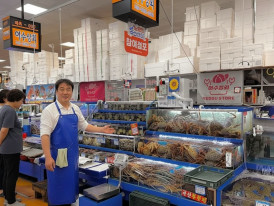
Noryangjin fish market stall with live tanks
Noryangjin Fish Market
Noryangjin Fish Market is Seoul's wholesale fish market, open early morning and late into the night. You can buy fresh seafood on the ground floor and take it upstairs to restaurants that'll cook it for you. It's more of a local supply market than a tourist food hall, but if you want fresh fish and don't mind the industrial setting, it's worth a visit.
At Noryangjin Fisheries Wholesale Market, you point at a live crab downstairs, carry it up, pay a cooking fee, and eat it with rice and banchan.
The setup is practical: buy fish, pay a cooking fee upstairs, eat it with basic banchan and rice. It's not fancy, but the fish is as fresh as it gets in Seoul. I don't bring tour groups here often because it's out of the way and the appeal is niche. But if you're into seafood markets, this is Seoul's main one.
What Food Traditions Shape How Locals Eat?
Seoul's eating patterns follow cultural rhythms older than the delivery apps. Some traditions persist because they work, not because they're quaint.
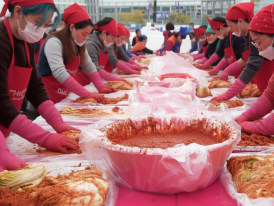
Kimjang (kimchi) making Festival
Kimjang (Kimchi-Making Season)
Kimjang happens in late autumn when families gather to make massive batches of kimchi for winter. It's a multi-day process involving salting cabbage, mixing the spice paste, and storing jars in cool spaces or special kimchi fridges.
Most Seoul residents don't make their own kimchi anymore. They buy it. But the cultural memory of kimjang is strong enough that it's recognized by UNESCO. Some neighborhoods still host community kimjang events. You'll see ajummas in parking lots brining cabbage and gossiping in Korean while they pack jars.
I don't make kimchi. I buy it like everyone else. But I respect the tradition and the sheer amount of labor that goes into the good stuff. When someone serves you homemade kimchi that's been fermenting for months, you say thank you and eat it.
Rainy-Day Jeon and Makgeolli Ritual
When it rains in Seoul, people crave jeon and makgeolli. The explanation I've heard is that the sound of rain resembles the sizzle of frying pancakes, which triggers the craving. That might be folk psychology. Either way, the pattern is real.
Pajeon (scallion pancakes) and bindaetteok (mung bean pancakes) are the main types. The pancakes are crispy on the outside, savory and slightly chewy inside, served with a soy vinegar dipping sauce. Makgeolli's tangy sweetness balances the fried richness.
I host guests at makgeolli houses on rainy nights because it's one of the few Seoul food rituals that feels participatory without being performative. You sit, you drink, you eat Korean pancakes. The rain does the rest.
Delivery Protocols and Late-Night Culture
Seoul's delivery culture is next-level efficient. You can order jjajangmyeon, fried chicken, or jokbal (braised pig's trotters) at 2 AM and have it arrive in 30 minutes. The drivers navigate alleys and apartment complexes faster than GPS can keep up.
Delivery fees surge on rainy nights and weekends, but the system still functions. Most restaurants provide metal containers for jjajangmyeon that you're expected to leave outside your door for pickup later. It's an honor system. Most people comply.
This isn't just convenience. It's woven into how people eat. Late-night cravings, solo dinners, lazy Sundays; delivery handles it all. The drivers are the unsung infrastructure of Seoul's food scene.
What Seasonal Foods Change the Eating Calendar?
Seoul's food culture pivots hard with the weather. Summer and winter hit different, and the menu follows.
Summer: Stamina and Cold Relief
Summer in Seoul is humid and miserable. The food response is samgyetang (hot ginseng chicken soup to build stamina) and naengmyeon (icy buckwheat noodles to cool down). It's fighting heat with heat, then cooling off with cold noodles and shaved ice.
Samgyetang days (삼복날) are marked on the calendar. People line up at samgyetang restaurants to eat hot soup in July because tradition says it boosts energy. Whether it works scientifically, I can't say. But the ritual persists.
Bingsu sales spike. Every café adds fruit toppings to their shaved ice menu. Naengmyeon restaurants stay packed through August. The seasonal pivot is real and visible.
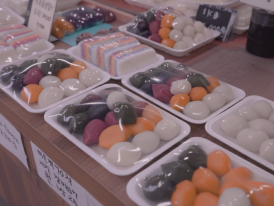
Songpyeon for the harvest festival
What Seasonal Foods Change the Eating Calendar?
Autumn: Harvest and Kimjang Prep
Autumn brings persimmons, chestnuts, and songpyeon (half-moon rice cakes) during Chuseok, Korea's harvest festival. Markets sell roasted chestnuts on street corners. The air cools enough that outdoor eating becomes pleasant again.
This is also kimjang season. The markets stock massive amounts of cabbage, radish, garlic, and gochugaru. Families prepare for winter by making enough kimchi to last months. Even if most Seoul residents outsource this now, the cultural rhythm still shapes what's sold and when.
Winter: Warming Sweets and Comfort Stews
Winter food in Seoul is about staying warm. Hotteok and bungeoppang vendors appear near subway stations. Roasted chestnuts and sweet potatoes sell from carts. The air smells like charcoal and burnt sugar.
Stews dominate restaurant menus. Kimchi jjigae, sundubu jjigae (soft tofu stew), and budae jjigae (army stew with spam and instant noodles) all hit harder when it's cold outside. The logic is simple: hot food in cold weather.
I drink more makgeolli in winter because it warms you from the inside. Sikhye (sweet rice drink) shows up at markets as a dessert option after heavy meals. The seasonal shifts are practical, not romantic.
What If Your Next Seoul Day Didn’t Come From a Guidebook?
Instead of following a script, we connect you with someone who lives there and knows the places worth your time.What Food Experiences Should You Skip or Adjust?
Not every famous spot delivers. Some places lean too hard on tourist traffic, others just aren't worth the markup or wait.
Myeongdong Tourist Stalls: Tweak or Skip
Myeongdong has street food stalls aimed squarely at tourists. The food isn't bad, but it's overpriced and crowded. If you're already there for shopping, fine. But don't make a special trip.
Tweak: Visit early on weekdays to avoid the worst queues. The vendors sell the same tteokbokki, hotteok, and skewers you'll find elsewhere, just with longer waits and higher prices.
Alternative: Gwangjang Market or Dongdaemun night market offer better food with more authentic energy. The vendors there cook for locals, not Instagram.
Insadong Tea Houses: Traditional but Overpriced
Insadong markets itself as Seoul's traditional culture district. The tea houses are pretty, the tea ceremonies are nice, but you're paying for ambiance more than beverage quality.
Alternative: Ikseon-dong, just east of Insadong, has indie cafés tucked into old hanok buildings. You get traditional architecture without the tea-ceremony markup. The coffee and desserts are better too.
Insadong Is Not Just Another Place on the List
Experience it through hidden corners and stories most visitors miss.
Itaewon BBQ Chains: Generic Compared to Mapo
Itaewon has Korean BBQ restaurants catering to international visitors. They're fine. The meat is fine. The service is English-friendly. But they lack the smoke, noise, and elbow-to-elbow energy of actual neighborhood BBQ halls.
Alternative: Mapo Jeong Daepo or any of the charcoal samgyeopsal alleys in Mapo. You'll queue longer, but the experience is worth it. The smoke matters. The communal vibe matters.
What Do You Need to Know Before Eating Here?
The logistics matter. Queue strategy, payment norms, basic etiquette, and accessibility notes that make the difference between smooth eating and frustration.
Ordering Without Korean
Most restaurants in central Seoul have picture menus or tablet ordering systems. Google Translate's camera function works on Korean menus with decent accuracy. Pointing also works.
Street food vendors usually have samples displayed. You point at what you want, they nod, you pay. The system is simple. Don't overthink it. Most street food vendors display everything; point and pay. At busy food stalls, finish and move, turnover is the culture.
At BBQ restaurants, staff will often help you grill if you look confused. They're used to foreigners who don't know the timing. Just ask (or gesture) if you need help.
Queue Windows and Booking Reality
Seoul doesn't do reservations at most casual restaurants. You show up, you wait. BBQ places queue hard after 6:30 PM. Markets are easier before 11 AM or after 2 PM. Late-night pojangmacha tents fill up after midnight but turn over quickly.
If you hate waiting, eat at off-peak times. Early dinners (5-6 PM) and late lunches (2-3 PM) usually have shorter waits. The food is the same. The energy might be lower, but you'll get seated faster.
Step-Free Access Notes
Gwangjang and Namdaemun markets are mostly step-free but get narrow at peak times. Some traditional BBQ halls have thresholds or raised floors that require shoe removal. Pojangmacha tents vary. Some have stable seating, some don't.
If mobility is a concern, stick to modern restaurants and main market alleys. Older neighborhoods and basement pojangmacha can be harder to navigate. Ask before committing if you're unsure.
Paying and Tipping
Cards and mobile payments are accepted almost everywhere; a few traditional market stalls may still prefer cash. Convenience stores and chain spots take cards everywhere. Street vendors and market stalls selling our favorite Korean foods often operate cash-only.
Tipping is not expected. The bill is the bill. Trying to tip can confuse staff or feel awkward. Just pay what's listed.
Basic Etiquette Reminders
- Share dishes. Traditional Korean meals are communal. Don't hoard the best banchan.
- Pour for others. Especially soju. Never pour for yourself if you're drinking with others.
- Shoes off in traditional rooms. If you see a raised floor, remove your shoes before stepping up.
- Chopsticks flat. Don't stick them upright in rice. That's for funerals.
- Sesame seeds and sesame oil. Use them when offered. They improve everything.
Plan Smarter, Travel Better
Chat with someone who lives there and avoid wasting time on tourist traps.
Frequently Asked Questions
1. What is the most popular Korean food?
Kimchi shows up at every meal. BBQ (samgyeopsal and galbi) is what people think of first. Fried chicken and beer (chimaek) is weekend culture. If I had to pick one thing that defines Seoul's food scene, it's the combination of kimchi, grilled meat, and communal eating with too much soju.
2. What are the best Korean street food items to try?
Tteokbokki, hotteok, and gimbap cover the basics. Bindaetteok from Gwangjang Market if you want something fried and savory. Eomuk broth if you're cold. Bungeoppang if it's winter. Late-night pojangmacha ramyeon if you're drunk.
3. Is Korean BBQ expensive?
Depends on the cut. Samgyeopsal is reasonable. Galbi costs more because it's short ribs. Budget $15-30 per person at neighborhood spots, more at fancier places. The banchan and rice are unlimited, which helps stretch the meal.
4. Where can I eat Korean BBQ like a local?
Mapo has the best concentration of charcoal samgyeopsal halls. Look for smoke, queues, and metal scissors on the tables. Avoid places with gas grills. The charcoal matters for flavor and authenticity.
5. What should I eat for breakfast in Seoul?
Soup and rice at a neighborhood diner. Some people do toast and coffee at cafés. Convenience stores sell triangle gimbap and banana milk if you're in a hurry. Breakfast isn't Seoul's strong suit compared to lunch and dinner.
6. Is street food in Seoul safe to eat?
Yes. Vendors cook food fresh in front of you. The turnover is high, so nothing sits around getting stale. Use common sense. If a stall looks abandoned or the food looks off, skip it. But most street food is fine.
7. What food should I avoid in South Korea?
Avoid nothing. Try everything once unless you have dietary restrictions. If you don't eat raw food, skip yukhoe (beef tartare). If you're vegetarian, Korean food is harder because meat and fish broth are everywhere. But there's no "dangerous" food here.
8. Do I need to tip at restaurants in Seoul?
No. Tipping isn't part of the culture. The bill is the bill. Trying to tip can confuse staff. Just pay what's listed.
9. Can I find vegetarian food in Seoul?
It's harder than in other Asian cities. Most traditional Korean dishes use anchovy broth or include meat. Temple food restaurants (사찰음식) serve Buddhist vegetarian meals, but they're not common. Bibimbap can be made vegetarian if you skip the meat. Convenience stores have vegetarian gimbap options.
10. What's the deal with Korean side dishes (banchan)?
Banchan refills are common, though not universal. Many restaurants will top them up if you ask politely. They're meant to be shared. Don't feel obligated to finish them all. Koreans rarely do. The variety makes every meal feel abundant even if the main dish is simple.
11. Is Seoul food spicy?
Some of it. Gochugaru (Korean chili flakes) and gochujang (chili paste) are everywhere, but the heat level is moderate compared to Thai or Sichuan food. Tteokbokki and dakgalbi are spicy. Samgyeopsal and naengmyeon are not. You can usually ask for less spice.
12. What food markets should I visit in Seoul?
Gwangjang for bindaetteok and mayak gimbap. Namdaemun for hotteok and walking snacks. Noryangjin if you're into fresh seafood. Dongdaemun night market for late-night street food. Those four cover the main market experiences.
13. What's the best area for food in Seoul?
Depends on what you want. Mapo for BBQ. Gwangjang for markets. Hongdae for fried chicken and youth food. Itaewon for international options. Jongno and Euljiro for old-school BBQ alleys and pojangmacha. There's no single "best" area. Each Seoul neighborhood has its own food rhythm.
14. How do I use Google Maps for food in Seoul?
Google Maps works fine for location but restaurant names are often in Hangul (Korean script). Use the app's translate feature or ask someone to type the name in Korean. Most venues show up once you have the correct characters.
15. What drinks pair with Korean food?
Soju with BBQ. Makgeolli with jeon. Beer with fried chicken. Sikhye after heavy meals. Korean rice (and all the food) pairs with pretty much anything alcoholic because the culture is built around drinking with food.
16. Is it worth coming back to Seoul, South Korea just to eat?
If you visit Seoul for food alone, you won't run out of options.

Nighttime Seoul street scene with pojangmacha tents and late night crowds
Final Thoughts: How to Eat Like You Live Here
Korean experiences and food scene aren't a checklist. It's a rhythm. You eat jjigae on days when you're tired. You grill samgyeopsal on Friday nights with coworkers. You order jjajangmyeon when you're too lazy to cook. You eat jeon and drink makgeolli when it rains. You stop for hotteok when it's cold. You drink too much soju and end up at a pojangmacha tent at 2 AM, eating instant ramyeon with strangers.
I host street food strolls and join guests at BBQ halls not because I'm trying to sell you an experience, but because this is how I eat. The markets, the smoke, the queues, the metal chopsticks, the endless banchan: it's all part of living here. You don't need a guide to decode it. You just need to show up hungry and willing to eat where the smoke and noise lead you.
If you want to go beyond eating, explore hidden gems in Seoul in quieter alleys, compare the best neighborhoods by food density, and plan things to do at night when pojangmacha tents go up.
Seoul's table is big, the portions are generous, and the soju keeps flowing. Come hungry. Leave full. Repeat.
More Seoul For You
Ready to Plan Your Perfect Day in Seoul?
Start your experienceTravel Guides Can Only Take You So Far
City Unscripted connects travelers with locals who shape days that actually fit your interests, not someone else’s checklist.
Wish you had a local friend in Seoul?
One who knows the city inside out and could plan a private day just for you? Our local hosts do exactly that: no scripts, no tourist traps, just the side of the city most people miss.

